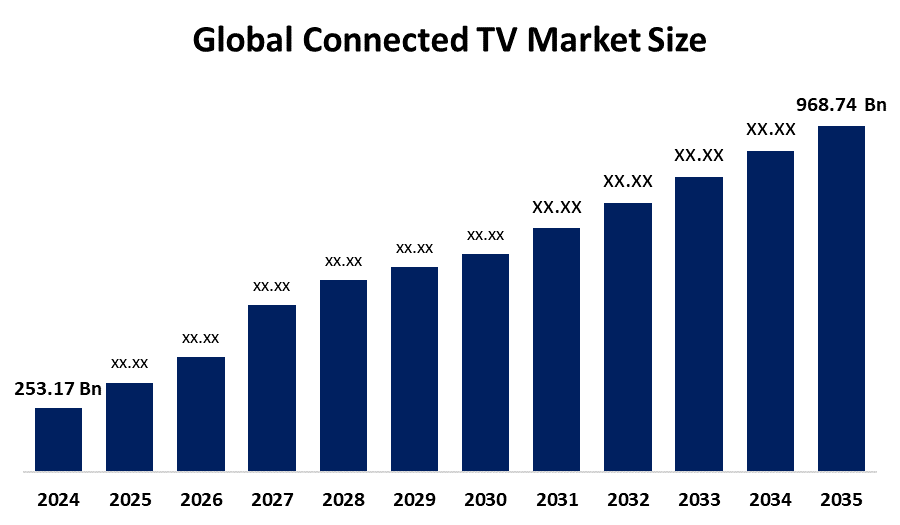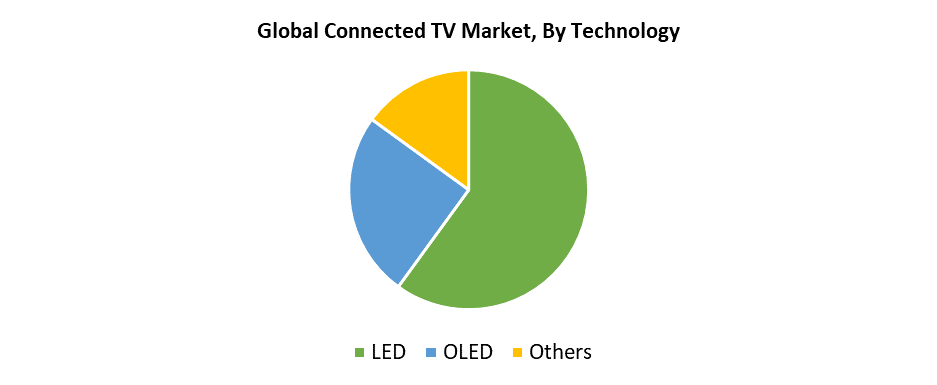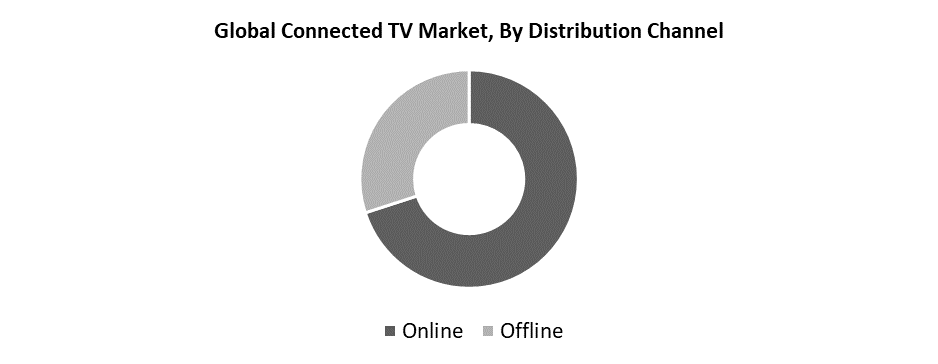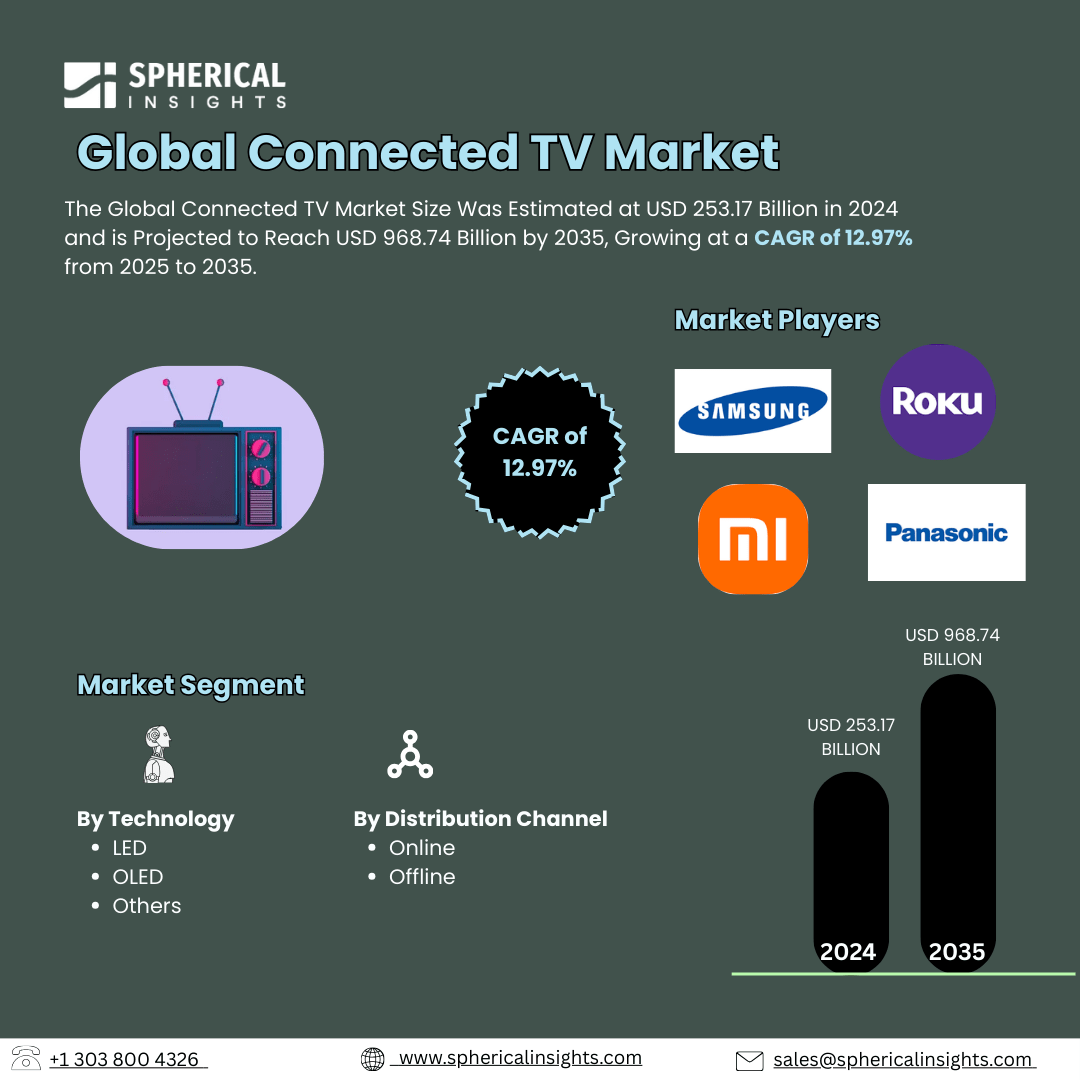Connected TV Market Summary
The Global Connected TV Market Size Was Estimated at USD 253.17 Billion in 2024 and is Projected to Reach USD 968.74 Billion by 2035, Growing at a CAGR of 12.97% from 2025 to 2035. The move from traditional TV to streaming services, the rising cost of smart TVs, and the accessibility of high-speed internet are the main factors propelling the connected TV (CTV) market's expansion.
Key Regional and Segment-Wise Insights
- In 2024, Asia Pacific held the largest revenue share of over 37.27% and dominated the market globally.
- In 2024, the LED segment had the highest market share by technology.
- In 2024, the online segment had the biggest market share by distribution channel.
Global Market Forecast and Revenue Outlook
- 2024 Market Size: USD 253.17 Billion
- 2035 Projected Market Size: USD 968.74 Billion
- CAGR (2025-2035): 12.97%
- Asia Pacific: Largest market in 2024

The market for connected TV, or CTV, consists of smart TVs, streaming sticks, and game consoles that enable consumers to stream digital content through their internet-connected devices. The market for connected TV is experiencing rapid growth because consumers demand individualized on-demand entertainment. Streaming services Netflix and Disney+, and Amazon Prime Video offer easy access to entertainment, which leads consumers to abandon traditional cable and satellite television systems. Home entertainment technology advances through 4K and 8K resolution along with OLED and QLED display technology and AI-based content recommendation systems. Connected TVs provide unique features through personalized interfaces together with voice control and smart home integration that differentiate them from traditional TV models. The latest technology attracts customers who want advanced entertainment systems which match their connected way of life, together with their increasing digital media requirements and their interest in immersive content.
The rapid increase of high-speed internet combined with smart home ecosystem development accelerates worldwide adoption of connected TVs. The combination of better broadband infrastructure enables users to play cloud games while optimizing AI content in real-time and stream videos smoothly. Connected TVs evolve into automation centers that combine entertainment services and communication features and support smart home adoption. The rise of OTT platforms together with AVOD models attracts younger viewers and cord-cutters by delivering affordable and flexible content access. The growth of connected TVs receives strong regional support from Asia-Pacific because of urbanization and rising incomes, 5G expansion, enhancing accessibility and streaming quality, while North America and Europe benefit from advanced infrastructure.
Technology Insights

LED technology remains dominant in the connected TV industry because it provides affordable prices along with good performance and easy accessibility to consumers. LED TVs represent an improved version of traditional LCD screens because they feature thinner designs and brighter images through energy-saving backlighting technology. The product's affordability allows it to attract various consumer groups, including budget-conscious individuals and those seeking to upgrade their outdated television models. The affordable nature of LED smart TVs enables widespread adoption throughout emerging markets because local consumers focus on price sensitivity. The integration of LED technology with commonly used smart TV operating systems and streaming services creates an enhanced user experience for customers. The affordable nature of LED technology continues to strengthen its market position because manufacturers keep improving display quality and production efficiency.
OLED display technology provides exceptional visual performance and premium market appeal, which leads to its quick adoption in modern connected TVs. The combination of ultra-thin design and vivid colors, along with wide viewing angles and perfect black levels from self-emissive pixels, makes OLED TVs deliver an immersive and visually impressive experience. High-end buyers find OLED attractive because of continuous technological advancements that include 4K, 8K resolution, and AI screen enhancements and elevated brightness levels. The decreasing production costs combined with larger panel sizes have expanded OLED usage from luxury consumers to a more extensive market base. LG, along with Sony and Samsung, leads the industry in developing wireless flexible OLED panels that drive innovation for top firms. The increasing demand for premium streaming experiences, together with rising global disposable incomes, makes OLED technology transform the high-end smart TV sector.
Distribution Channel Insights

The connected TV (CTV) market's online distribution segment led in 2024 because internet penetration increased with a reduction in costs and growing convenience. The diverse selection of CTV models on e-commerce platforms, along with reasonable prices and user reviews, attracts both young and technologically proficient buyers who want smart purchase decisions. Online shopping saw exponential growth throughout the COVID-19 pandemic, and the momentum continues because of enhanced delivery services and flexible payment solutions, and hassle-free product returns. Through online channels, manufacturers can establish direct-to-consumer sales, which removes intermediaries and enables precise marketing approaches. The CTV sector's online distribution serves as a fundamental development driver because it reduces operational expenses while improving customer relationships and broadening market reach.
The connected TV market will experience a substantial surge in the offline distribution segment throughout the forecast period because consumers desire physical transaction experiences. Shoppers commonly want to handle and evaluate products directly before making substantial investments such as buying a television. Physical stores deliver interactive product demonstrations along with expert assistance and immediate product access that enhance consumer trust. Buying incentives, including value-added packages and seasonal promotions, often draw offline store shoppers to complete their purchases. Offline distribution maintains market dominance in developing countries because these areas lack internet access while traditional buying habits persist. The combination of these factors creates a permanent need for offline distribution within the global expansion of the connected TV market.
Regional Insights
The connected TV market in North America has accounted for a USD 78.6 billion revenue share in 2024, primarily because of its technological early adopters, widespread broadband access, and substantial consumer spending. The developed OTT ecosystem of North America drives strong demand for connected TV because it offers numerous streaming services and content providers. The user experience improves significantly through voice control and AI-powered content recommendations and 4K/8K screen technology. The active investments by major manufacturers and tech companies into smart TV platforms drive both strong competition and quick technical advancement. The United States and Canada lead the industry because they implement ad-supported streaming models alongside AI-driven content personalization and advanced display technologies. The high smart TV adoption rate, along with reliable internet infrastructure, ensures North America's leading position in the connected TV market, combined with steady market growth.
Europe Connected TV Market Trends
The European connected TV market experiences continuous growth because customers want high-quality entertainment systems that integrate with smart home devices. The UK, together with Germany and France, leads European adoption because they have improved internet infrastructure and easy access to large streaming content collections. The rising awareness of environmental issues among customers drives manufacturers toward developing eco-friendly smart TVs, which they can sell to customers. Europe's favorable regulatory framework, together with ongoing digital transformation initiatives, enhances the adoption rate of linked TVs in urban regions. The market growth results from increasing demand for interactive capabilities together with personalized viewing options. Europe represents a dynamic region that experiences fast growth in the worldwide connected TV industry because of these combined factors.
Asia Pacific Connected TV Market Trends
The Asia Pacific region led the connected TV market globally, accounting for 37.27% revenue share in 2024 because of expanding middle classes in China and India, along with rapid urbanization and increasing disposable income levels. The widespread deployment of 5G networks combined with affordable smart TVs and growing internet access enables millions of people to stream content without interruptions. The fast adoption rate of OTT platforms, which deliver varied local content, drives the overall market growth. The market expansion benefits from governmental digital programs along with investments in advanced display technologies such as OLED and QLED. The combination of affordable smart TVs and AI streaming services with strong digital networks drives major market development in China, India, and Japan. Asia Pacific stands as a rapidly developing area for connected TV growth because of its active market conditions.
Key Connected TV Companies:
The following are the leading companies in the connected TV market. These companies collectively hold the largest market share and dictate industry trends.
- Samsung Electronics
- Roku
- Panasonic Corporation
- Xiaomi Corporation
- Sharp Electronics
- Hisense Group
- Philips
- Skyworth
- Sony Corporation
- TCL Technology
- LG Electronics
- Haier Group
- Others
Recent Developments
- In October 2024, the BBC, ITV, Channel 4, and Channel 5 collaborated with Amazon to incorporate their free streaming service, Freely, into the Fire TV operating system. This collaboration is a significant step towards internet-delivered TV services and expands the streaming landscape by allowing UK viewers to watch live and on-demand TV without the need for an aerial.
Market Segment
This study forecasts revenue at global, regional, and country levels from 2020 to 2035. Spherical Insights has segmented the connected TV market based on the below-mentioned segments:
Global Connected TV Market, By Technology
Global Connected TV Market, By Distribution Channel
Global Connected TV Market, By Regional Analysis
- North America
- Europe
- Germany
- UK
- France
- Italy
- Spain
- Russia
- Rest of Europe
- Asia Pacific
- China
- Japan
- India
- South Korea
- Australia
- Rest of Asia Pacific
- South America
- Brazil
- Argentina
- Rest of South America
- Middle East & Africa
- UAE
- Saudi Arabia
- Qatar
- South Africa
- Rest of the Middle East & Africa






